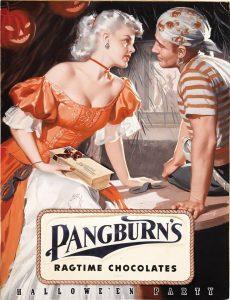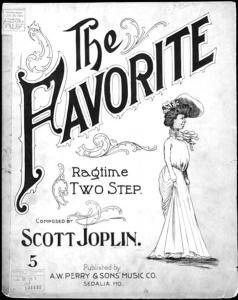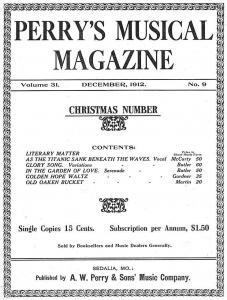 Fred Hoeptner’s paper on the origin and use of the term “ragtime” delivered at last Summer’s Joplin Festival in Sedalia has had me thinking about how ragtime was defined and received in “The Cradle of Ragtime.” Then Fred’s reference to ragtime as being implicated in mental pathologies back in 1910, in his TST article last month, caused me to blow off the dust on some archived Sedalia documents.
Fred Hoeptner’s paper on the origin and use of the term “ragtime” delivered at last Summer’s Joplin Festival in Sedalia has had me thinking about how ragtime was defined and received in “The Cradle of Ragtime.” Then Fred’s reference to ragtime as being implicated in mental pathologies back in 1910, in his TST article last month, caused me to blow off the dust on some archived Sedalia documents.
Musical Heritage
Old Sedalia, it seems has always has had an approach-avoidance conflict with the music that put the little town on the map. From Joplin’s emergence as “The King of Ragtime” after the publication of Maple Leaf Rag in 1899 through the pre-WWI era of ragtime, Sedalia often struggled with its musical heritage.

I have relied on Sedalia’s white newspapers from the 1890’s until WWI; the Perry’s Musical Magazine articles from the same period, and the mostly African-American George R. Smith College newspaper, The Conservator, that served the Black community from 1903-1909, in studying the community’s perspective on ragtime.
The Perry Music Company
The story of Sedalia’s venerable Perry Music Company is widely known. However, for those unfamiliar with the telling, I refer you to Bill Edward’s essay at ragpiano.com/pubs/perry.shtml. From 1881 until July 1967 the old publishing house produced its monthly “Perry’s Musical Magazine.” Until World War II the four to eight musical scores per issue were accompanied by various essays of musical interest written mostly by Austin W. Perry’s son Andrew who ran the printing business.
The company published a variety of ragtime and cakewalk compositions through the years beginning with a pseudo-syncopated piece by Phillip Perry titled, Sambo’s Double Shuffle in 1883 and later such titles as Frivolous Rags, Missouri Rag by Maie Fitzgerald (like Settles from New Franklin, Missouri), How Reuben Does the Rag, and Stenotype Rag. Andrew or his father bought and published Joplin’s The Favorite in 1904, and of course there is Edgar Settle’s X.L. Rag published in 1903 in an effort to cash in on ragtime’s popularity, though a bit late.

Public Sentiment
While Sedalia seemed appropriately proud of Scott Joplin’s musical genius, the citizens didn’t necessarily share the same disposition when it came to ragtime or syncopation in general. However, to their credit, they seemed to be able to generally differentiate Joplin’s classic ragtime style from the popular ragtime pieces of the day.
As soon as fifteen months after the 1899 publication of Maple Leaf Rag, The Sedalia Weekly Sentinel, in an article on the popularity of dancing, declared, “The undignified ragtime and cake walk will probably be strictly eliminated from (programs). The dancing masters declare the ragtime type of dancing destroys all the grace and beauty which should represent the terpsichorean art and they are loud in their denunciation of what they call a ‘deep-rooted evil.’”
I have just completed cataloging the Sedalia Archive copies of Perry’s Musical Magazine published from 1881 and 1967. (Incidentally, between the Labudde Collection at the University of Missouri-Kansas City and the Sedalia Archive, we now have 444 issues, or about one third of the 1291 issues published.) The Perry articles on or referring to ragtime are sparse but reflect my earlier observation that they distinguished between Joplin’s classic ragtime and syncopated pieces in general.
A December 1900 article attempting a definition of ragtime states that “it is a rhythm which is the most characteristic feature of what may be called American-Negro music.” In stereotypical terms, Perry then goes on to describe the “strong rhythmical sense which is innate with [the compositions].” Additionally, the author confesses his ignorance of the origin of the term “ragtime.”
Newspaper Mentions
In a June 1901 Perry essay on “Moral Music,” Andrew wrote, “shall we infer then that while the music of a master effects the higher plane of our emotions, the (for instance) feverish rag-time coon-music arouses emotions of a lower and more primitive grade? It is certain that there is a touch of the savage lurking in the best of men, and nothing will probe this hidden depth of human nature as well as garish (ragtime) music.” Ouch!
Still the next month, Perry implies in an essay on “Music in America” that though the nation had not yet created its own distinctive music, “A while ago I suggested that inspiration for truly national music might be derived from the Negro melodies…” By these he seems to have meant “plantation songs” which he would later attribute to Scotch origins and not African-slave songs.
Then, but a month later waxing rather eloquently if still a bit condescending he writes:
“Negro music is natural music—music that has evolved itself form the soul and spirit of these who give utterance to it and the sufferings of the race have given it soberness…[it is] wild, rollicking and bubbling over with animal spirits. But the sorrows of a bitter experience have come to blend with the natural light-heartedness of the race, and the result is, a music at one moment jubilantly gay and the next unutterably sad—a music of sharp contrasts and strange harmonious discords.”
The same issue featured an article from The Chicago News that attempted a tongue-in-cheek essay on “An Evolution of Rag-time,” that made a joke of the current ragtime songs.
The George R. Smith College newspaper The Conservator, on commencing publication in 1903 almost immediately took aim at ragtime, admonishing readers to “run less after ‘ragtime melodies’ [and instead] write prose and verse, [and] study the art of expression, oral and written.”
Scott Joplin
Joplin had moved to St. Louis in 1900 but returned to Sedalia in 1904 to great fanfare. The famous St. Louis Globe Democrat article of August 1904 praising Joplin and his music and quoting international sources as advocating his gifted compositions, resonated well back in Sedalia. However, it was while in Sedalia that Joplin’s wife of only a few weeks died suddenly and that tragedy evoked great sympathy from the community.
Sooner “Squelched” The Better
The following year, The Conservator once again took on ragtime as “an evil appealing only to emotion alone.” It declared, “ragtime does not stir the finer and divinest sentiments of the entire character as does the productions of the German, Italian, Hungarian, or English masters. All this was in an article titled, “Away with the Rag-Time Music.” In another article of the same issue titled “Rag-time Becoming Unpopular” the editor declared “Disapproval has been stamped upon the ‘ragtime’ musician by the cultured element of the race. The sooner it is completely squelched, the better.” But it was the first article that best explains the African-American paper’s bias, “Locate the ‘Rag-time’ compositions and you will hear them reverberated from the wine halls, the brothels, the homes of the disreputable…” And there is was, the reputation that this music, America’s music, came from disreputable origins, thus branding it disreputable.
The Conservator’s barrage continued with articles on “The Decadence of Ragtime Music” in 1907 while minstrel shows in Sedalia theaters remained popular blatantly ridiculing African-Americans through racist black-face routines. In 1912 a Sedalia Democrat article stated “ragtime music proves as vicious and demoralizing as the grizzly bear and other forms of indecent dances.”
Also in 1912, Andrew Perry is lamenting in his monthly magazine that “sadly…the wisest music critic who ever lived would have to wait for several generations before he could tell American music from that belonging to any other race…” Yet that very music was sweeping the country as he wrote.
Attempting to settle the question of ragtime’s legacy, a 1915 Sedalia Democrat article began, “The modern ragtime music, so called, may be considered a temporary aberration.” Instead, they declared that it would be not Scott Joplin but Stephen Foster who would come to most represent American music and reflect the era of the time.
Some Got it Right
However, I’ll let Andrew Perry settle the matter, at least in Sedalia’s era of ragtime, with his statement in the June 1915 Perry magazine, “Kilometric music, or mere sound, in ragtime, as elsewhere is quickly forgotten. The type of ragtime that is good has proved its worth by being universally accepted. It is principally, I think, the rhythm that attracts…and in years to come it will it will surely have a strong influence on American music.”
It would seem that Sedalia in the ragtime era was typical of the rest of the nation. The white community briefly embraced syncopation in all its forms while at the same time ridiculing its origins. The African-American community on the other hand soon realized that “their” ragtime music branded them as debauched because of the venues where it originated, not as musical innovators for the genius of ragtime’s musical innovation.
That is why I believe Sedalia is wise to be changing the focus of its ragtime heritage from the Main Street Tenderloin and Maple Leaf Club site to the 114 E. Fifth Street site of the John Stark Music Company where the famous Maple Leaf Rag contract was signed on August 10, 1899. And, I must note, while ragtime in all its exhilarating forms is today composed and played by all manner of amazingly gifted and talented performers, Joplin’s classical ragtime pieces have attained the ultimately classical stature to which Scott Joplin aspired. This is nowhere better evidenced than by Richard Dowling’s brilliant concerts memorializing the composer’s death centennial.
Larry Melton was a founder of the Scott Joplin Ragtime Festival in 1974 and the Sedalia Ragtime Archive in 1976. He was a Sedalia Chamber of Commerce manager before moving on to Union, Missouri where he is currently helping to conserve the Ragtime collection of the Sedalia Heritage Foundation. Write him at lcmelton67@gmail.com.






















